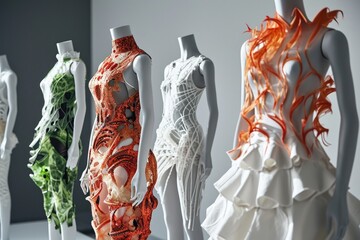
Fashion Design Specialization
The Fashion Design specialization is dedicated to nurturing creativity, innovation, and visual storytelling in clothing and apparel. This path emphasizes the complete design process—from initial inspiration to finished concept—giving students the skills and insight needed to create original, market-ready fashion collections.
Students will develop a strong foundation in the principles of design, master the art of visual communication through drawing and digital tools, and gain a deep understanding of cultural influences, consumer behavior, and aesthetic trends.
1. Fashion Illustration
Fashion illustration is the visual language of design. This subtopic teaches students how to sketch garments and figures accurately and expressively, both by hand and using digital tools. Emphasis is placed on proportions, movement, and fabric texture to bring the designs to life on paper or screen.
-
Learn different types of fashion figures (croquis)
-
Practice rendering fabrics such as silk, denim, leather, and lace
-
Use markers, watercolors, pencils, and digital software (e.g., Adobe Illustrator, Procreate)
-
Develop a personal illustration style to enhance portfolio presentation
2. Design Development
This module walks students through the complete creative process that turns an idea into a finished collection. It starts with finding inspiration and ends with garment prototypes and a cohesive design board.
-
Research themes, cultures, art, or social issues for design inspiration
-
Create mood boards and concept boards to organize and present ideas visually
-
Select color palettes based on seasonal trends and emotional impact
-
Choose suitable fabrics and trims for the design purpose
-
Develop initial sketches into detailed designs ready for construction
3. Fashion History and Trends
Understanding the evolution of fashion is essential for designing with cultural awareness and innovation. This subtopic provides insights into the historical context, iconic designers, and recurring trends that shape the fashion world.
-
Study key fashion eras (e.g., Victorian, Art Deco, 1960s mod, 1990s minimalism)
-
Analyze the work of influential designers such as Coco Chanel, Alexander McQueen, and Rei Kawakubo
-
Learn how socio-political events, art, and technology influence clothing styles
-
Develop the ability to forecast future trends by observing current events and consumer behavior
4. Computer-Aided Design (CAD)
In today’s fashion industry, digital proficiency is crucial. CAD helps designers translate their creative ideas into precise, professional, and production-ready graphics.
-
Use industry-standard software (such as Adobe Illustrator, CLO 3D, or CorelDraw)
-
Create technical flats (flat garment sketches that show construction details)
-
Apply digital colors, textures, and patterns to fashion drawings
-
Build digital portfolios and design presentations for manufacturers or clients
-
Learn basic 3D garment visualization for realistic garment fitting and simulation
- Teacher: Admin User



